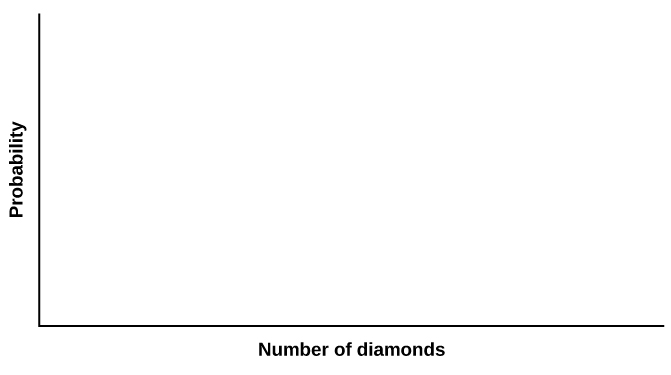Chapter 4.8: Discrete Distribution (Playing Card Experiment)
Class Time:
Names:
- The student will compare empirical data and a theoretical distribution to determine if an everyday experiment fits a discrete distribution.
- The student will compare technology-generated simulation and a theoretical distribution.
- The student will demonstrate an understanding of long-term probabilities.
- One full deck of playing cards
- One programming calculator
ProcedureThe experimental procedure for empirical data is to pick one card from a deck of shuffled cards.
- The theoretical probability of picking a diamond from a deck is _________.
- Shuffle a deck of cards.
- Pick one card from it.
- Record whether it was a diamond or not a diamond.
- Put the card back and reshuffle.
- Do this a total of ten times.
- Record the number of diamonds picked.
- Let X = number of diamonds. Theoretically, X ~ B(_____,_____)
- Record the number of diamonds picked for your class with playing cards in (Figure). Then calculate the relative frequency.
x Frequency Relative Frequency 0 __________ __________ 1 __________ __________ 2 __________ __________ 3 __________ __________ 4 __________ __________ 5 __________ __________ 6 __________ __________ 7 __________ __________ 8 __________ __________ 9 __________ __________ 10 __________ __________ - Calculate the following:
 = ________
= ________- s = ________
- Construct a histogram of the empirical data.

- Build the theoretical PDF chart based on the distribution in the Procedure section.
x P(x) 0 1 2 3 4 5 6 7 8 9 10 - Calculate the following:
- μ = ____________
- σ = ____________
- Construct a histogram of the theoretical distribution.

Using the Data
RF = relative frequency
Use the table from the Theoretical Distribution section to calculate the following answers. Round your answers to four decimal places.
- P(x = 3) = _______________________
- P(1 < x < 4) = _______________________
- P(x ≥ 8) = _______________________
Use the data from the Organize the Data section to calculate the following answers. Round your answers to four decimal places.
- RF(x = 3) = _______________________
- RF(1 < x < 4) = _______________________
- RF(x ≥ 8) = _______________________
Discussion QuestionsFor questions 1 and 2, think about the shapes of the two graphs, the probabilities, the relative frequencies, the means, and the standard deviations.
- Knowing that data vary, describe three similarities between the graphs and distributions of the theoretical, empirical, and simulation distributions. Use complete sentences.
- Describe the three most significant differences between the graphs or distributions of the theoretical, empirical, and simulation distributions.
- Using your answers from questions 1 and 2, does it appear that the two sets of data fit the theoretical distribution? In complete sentences, explain why or why not.
- Suppose that the experiment had been repeated 500 times. Would you expect (Figure) or (Figure) to change, and how would it change? Why? Why wouldn’t the other table(s) change?

